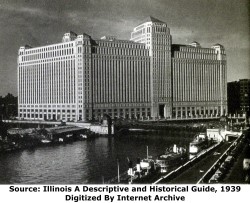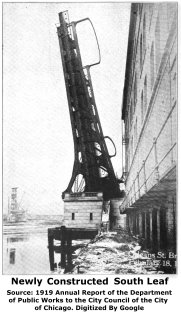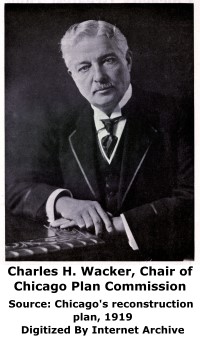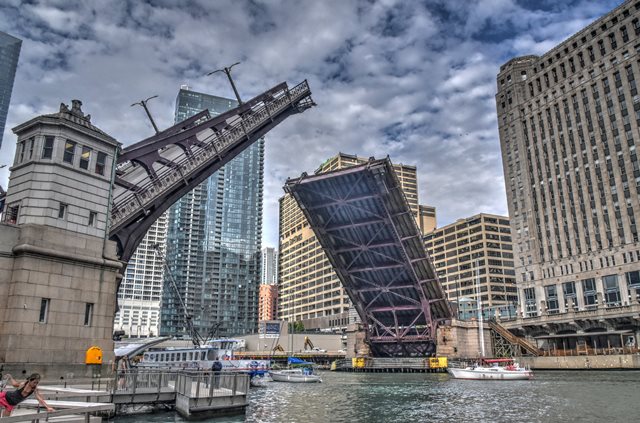We Recommend:
Bach Steel - Experts at historic truss bridge restoration.
BridgeHunter.com Phase 1 is released to the public! - Visit Now
Franklin Street Bridge
Franklin-Orleans Bridge

Primary Photographer(s): Nathan Holth
Bridge Documented: August 12, 2006, 2009-2013
Chicago: Cook County, Illinois: United States
Metal Rivet-Connected Pratt Pony Truss, Movable: Double Leaf Bascule (Fixed Trunnion) and Approach Spans: Metal Stringer (Multi-Beam), Fixed
1920 By Builder/Contractor: Ketler-Elliott Company of Chicago, Illinois and Engineer/Design: City of Chicago
2002
252.0 Feet (76.8 Meters)
320.0 Feet (97.5 Meters)
38 Feet (11.58 Meters)
1 Main Span(s) and 5 Approach Span(s)
16602027330

View Information About HSR Ratings
Bridge Documentation
View Archived National Bridge Inventory Report - Has Additional Details and Evaluation
View Historic American Engineering Record (HAER) Documentation For This Bridge
HAER Data Pages, PDF

The last bridge to cross the Chicago River before it splits into the north and south branches, this bridge crosses the river at an angle, connecting Franklin and Orleans Streets, and lies in the shadow of the massive Merchandise Mart building which inescapably defines the visual setting around the bridge.
This trunnion bascule bridge, which features a pony truss superstructure was built in 1920. The contractor for the substructure of the bridge was the Great Lakes Dredge and Dock Company. The superstructure contractor was the Ketler-Elliott Company, although "Elliott" is actually spelled with only one "t" (Elliot) as is the case on a couple bridges. The original electrical equipment was installed by C.H. Norwood. The bridge is 62 feet wide, and has a 220 foot clear span with a 251.8 foot trunnion-to-trunnion span. There is 18.7 feet of navigational vertical clearance listed for the bridge.
This bridge is similar to the nearby Clark and La Salle Street Bridges, although the trusses are not quite as high, and not as fully rounded at the ends as Clark and LaSalle. For comparison, the Grand Avenue Bridge is an example of the earlier pony truss design that eventually evolved into the design seen with bridges like the Franklin Street Bridge. The unusual shape of these bridges comes from the fact that each leaf of this double-leaf bascule bridge is essentially cantilevered out from the abutments, meaning that the each end of the bridge is supporting its half of the bridge out to the center independently of the other half of the bridge.
Franklin Street Bridge retains the beautiful original railing design which includes flowers set into the panels. These railings are among the most beautiful to be found in Chicago.
When the original railings, ornate bridgetender buildings, and gracefully curved pony trusses are taken into account it is quite easy to argue that the Franklin Street Bridge is among the most beautiful of Chicago's bridges.
The Franklin Street Bridge was featured prominently in an advertisement by the Strauss Bascule Bridge Company of Chicago as seen above, right. Ironically however, the company was not involved with the Franklin Street Bridge in any direct manner. However, the company's founder Joseph Strauss successfully sued the City of Chicago because the trunnion girder design that the city used was found to infringe upon a bascule bridge patent that Joseph Strauss had. Because the court upheld Strauss's lawsuit, Strauss was able to produce this advertisement saying that Chicago's bridges used the "Strauss patented support for the trunnions" even though the city never had any contact with Strauss or his company in the process of building the bridge.
Above: A photo taken as construction was nearly complete on the bridge.
Above: A photo showing a project in 1953 to replace the bridge deck.
Above: Charles H. Wacker, after whom Wacker Drive is named, was a Chair of the Chicago Plan Commission when the Franklin Street Bridge was built.
|
Main Plaque WM. HALE THOMPSONMAYOR
HUGH E. YOUNG ENGINEER OF BRIDGE DESIGN CHICAGO PLAN COMMISSION E. H. BENNETT CONSULTING ARCHITECT CHICAGO CHAPT. OF AMER. INST. OF ARCH'TS. - CHICAGO ART COMM. CONSTRUCTION
ELECTRICAL EQUIPMENT BY C. H. NORWOOD 1920 |
Bridge Association Plaque BY AUTHORITY OF THE CITY COUNCIL THIS TABLET ISERECTED BY THE FRANKLIN-ORLEANS BRIDGE ASSOCIATION IN APPRECIATION OF THE SERVICE OF THOSE OFFICIALS AND CITIZENS WHO COOPERATION BROUGHT ABOUT THE CONSTRUCTION OF THIS BRIDGE. JAMES H. CHANNON, PRES. EDWARD MOHR, VICE PRES. JOSEPH E. FLANAGAN GEORGE R. DUNCAN HAMPDEN WINSTON, TREAS. JAMES F. BURNS, COUNCEL |
![]()
Historic Bridges of Chicago and Cook County


Chicago and Cook County are home to one of the largest collections of historic bridges in the country, and no other city in the world has more movable bridges. HistoricBridges.org is proud to offer the most extensive coverage of historic Chicago bridges on the Internet.
General Chicago / Cook County Bridge Resources
Chicago's Bridges - By Nathan Holth, author of HistoricBridges.org, this book provides a discussion of the history of Chicago's movable bridges, and includes a virtual tour discussing all movable bridges remaining in Chicago today. Despite this broad coverage, the book is presented in a compact format that is easy to take with you and carry around for reference on a visit to Chicago. The book includes dozens of full color photos. Only $9.95 U.S! ($11.95 Canadian). Order on Amazon.
Chicago River Bridges - By Patrick T. McBriarty, this is a great companion to Holth's book shown above. This much larger book offers an extremely in-depth exploration of Chicago's movable highway bridges, including many crossings that have not existed for many years. Order Now Direct From The Publisher! or order on Amazon.
View Historic American Engineering Record (HAER) Overview of Chicago Bascule Bridges (HAER Data Pages, PDF)
Chicago Loop Bridges - Chicago Loop Bridges is another website on the Internet that is a great companion to the HistoricBridges.org coverage of the 18 movable bridges within the Chicago Loop. This website includes additional information such as connections to popular culture, overview discussions and essays about Chicago's movable bridges, additional videos, and current news and events relating to the bridges.
Additional Online Articles and Resources - This page is a large gathering of interesting articles and resources that HistoricBridges.org has uncovered during research, but which were not specific to a particular bridge listing.
![]()
Photo Galleries and Videos: Franklin Street Bridge
About - Contact
© Copyright 2003-2026, HistoricBridges.org. All Rights Reserved. Disclaimer: HistoricBridges.org is a volunteer group of private citizens. HistoricBridges.org is NOT a government agency, does not represent or work with any governmental agencies, nor is it in any way associated with any government agency or any non-profit organization. While we strive for accuracy in our factual content, HistoricBridges.org offers no guarantee of accuracy. Information is provided "as is" without warranty of any kind, either expressed or implied. Information could include technical inaccuracies or errors of omission. Opinions and commentary are the opinions of the respective HistoricBridges.org member who made them and do not necessarily represent the views of anyone else, including any outside photographers whose images may appear on the page in which the commentary appears. HistoricBridges.org does not bear any responsibility for any consequences resulting from the use of this or any other HistoricBridges.org information. Owners and users of bridges have the responsibility of correctly following all applicable laws, rules, and regulations, regardless of any HistoricBridges.org information.
![]()












